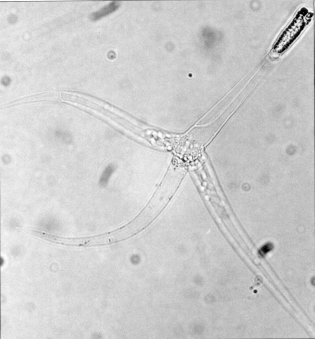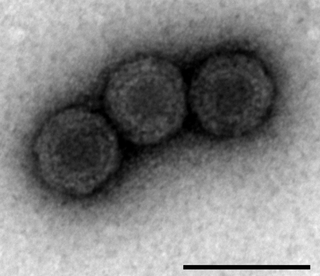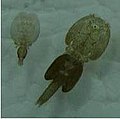
Salmon is the common name for several commercially important species of euryhaline ray-finned fish from the genera Salmo and Oncorhynchus of the family Salmonidae, native to tributaries of the North Atlantic (Salmo) and North Pacific (Oncorhynchus) basins. Other closely related fish in the same family include trout, char, grayling, whitefish, lenok and taimen, all coldwater fish of the subarctic and cooler temperate regions with some sporadic endorheic populations in Central Asia.

Fish farming or pisciculture involves commercial breeding of fish, most often for food, in fish tanks or artificial enclosures such as fish ponds. It is a particular type of aquaculture, which is the controlled cultivation and harvesting of aquatic animals such as fish, crustaceans, molluscs and so on, in natural or pseudo-natural environments. A facility that releases juvenile fish into the wild for recreational fishing or to supplement a species' natural numbers is generally referred to as a fish hatchery. Worldwide, the most important fish species produced in fish farming are carp, catfish, salmon and tilapia.

Myxobolus cerebralis is a myxosporean parasite of salmonids that causes whirling disease in farmed salmon and trout and also in wild fish populations. It was first described in rainbow trout in Germany in 1893, but its range has spread and it has appeared in most of Europe, the United States, South Africa, Canada and other countries from shipments of cultured and wild fish. In the 1980s, M. cerebralis was found to require a tubificid oligochaete to complete its life cycle. The parasite infects its hosts with its cells after piercing them with polar filaments ejected from nematocyst-like capsules. This infects the cartilage and possibly the nervous tissue of salmonids, causing a potentially lethal infection in which the host develops a black tail, spinal deformities, and possibly more deformities in the anterior part of the fish.

Oncorhynchus is a genus of ray-finned fish in the subfamily Salmoninae of the family Salmonidae, native to coldwater tributaries of the North Pacific basin. The genus contains twelve extant species, namely six species of Pacific salmon and six species of Pacific trout, all of which are migratory mid-level predatory fish that display natal homing and semelparity.
Kudoa thyrsites is a myxosporean parasite of marine fishes. It has a worldwide distribution, and infects a wide range of host species. This parasite is responsible for causing economic losses to the fisheries sector, by causing post-mortem "myoliquefaction", a softening of the flesh to such an extent that the fish becomes unmarketable. It is not infective to humans.
Infectious salmon anemia (ISA) is a viral disease of Atlantic salmon caused by Salmon isavirus. It affects fish farms in Canada, Norway, Scotland and Chile, causing severe losses to infected farms. ISA has been a World Organisation for Animal Health notifiable disease since 1990. In the EU, it is classified as a non-exotic disease, and is monitored by the European Community Reference Laboratory for Fish Diseases.

Sea lice are copepods of the family Caligidae within the order Siphonostomatoida. They are marine ectoparasites that feed on the mucus, epidermal tissue, and blood of host fish. The roughly 559 species in 37 genera include around 162 Lepeophtheirus and 268 Caligus species.

Broughton Archipelago Provincial Park is the largest marine provincial park located in British Columbia, Canada. The park is located in the Queen Charlotte Strait around 30 km east of Port McNeill, a town situated on Vancouver Island. In terms of its functions, the park offers tourism opportunities such as kayaking and whale watching, preserves a wide array of wildlife including many at-risk species, and has a long history of use by First Nation peoples.

Orthoreovirus is a genus of viruses, in the family Reoviridae, in the subfamily Spinareovirinae. Vertebrates serve as natural hosts. There are ten species in this genus. Diseases associated with this genus include mild upper respiratory tract disease, gastroenteritis, and biliary atresia. Mammalian orthoreovirus 3 induces cell death preferentially in transformed cells and therefore displays inherent oncolytic properties.

Henneguya zschokkei or Henneguya salminicola is a species of a myxosporean endoparasite. It afflicts several salmon in the genera Oncorhynchus and Salmo. It causes milky flesh or tapioca disease. H. zschokkei is notable for its lack of mitochondria, mitochondrial DNA, aerobic respiration and its reliance on an exclusively anaerobic metabolism.

Cleaner fish are fish that show a specialist feeding strategy by providing a service to other species, referred to as clients, by removing dead skin, ectoparasites, and infected tissue from the surface or gill chambers. This example of cleaning symbiosis represents mutualism and cooperation behaviour, an ecological interaction that benefits both parties involved. However, the cleaner fish may consume mucus or tissue, thus creating a form of parasitism called cheating. The client animals are typically fish of a different species, but can also be aquatic reptiles, mammals, or octopuses. A wide variety of fish including wrasse, cichlids, catfish, pipefish, lumpsuckers, and gobies display cleaning behaviors across the globe in fresh, brackish, and marine waters but specifically concentrated in the tropics due to high parasite density. Similar behaviour is found in other groups of animals, such as cleaner shrimps.

The salmon louse is a species of copepod in the genus Lepeophtheirus. It is a sea louse, a parasite living mostly on salmon, particularly on Pacific and Atlantic salmon and sea trout, but is also sometimes found on the three-spined stickleback. It feeds on the mucus, skin and blood of the fish. Once detached, they can be blown by wind across the surface of the sea, like plankton. When they encounter a suitable marine fish host, they adhere themselves to the skin, fins, or gills of the fish, and feed on the mucus or skin. Sea lice only affect fish and are not harmful to humans.

The aquaculture of salmonids is the farming and harvesting of salmonid fish under controlled conditions for both commercial and recreational purposes. Salmonids, along with carp and tilapia, are the three most important fish groups in aquaculture. The most commonly commercially farmed salmonid is the Atlantic salmon.

Like humans and other animals, fish suffer from diseases and parasites. Fish defences against disease are specific and non-specific. Non-specific defences include skin and scales, as well as the mucus layer secreted by the epidermis that traps microorganisms and inhibits their growth. If pathogens breach these defences, fish can develop inflammatory responses that increase the flow of blood to infected areas and deliver white blood cells that attempt to destroy the pathogens.

Emamectin is the 4″-deoxy-4″-methylamino derivative of abamectin, a 16-membered macrocyclic lactone produced by the fermentation of the soil actinomycete Streptomyces avermitilis. It is generally prepared as the salt with benzoic acid, emamectin benzoate, which is a white or faintly yellow powder. Emamectin is widely used in the US and Canada as an insecticide because of its chloride channel activation properties.

Alexandra Bryant Hubbard Morton is an American and Canadian marine biologist best known for her 30-year study of wild killer whales in the Broughton Archipelago in British Columbia. Since the 1990s, her work has shifted toward the study of the impact of salmon farming on Canadian wild salmon.
Piscirickettsia salmonis is the bacterial causative agent of piscirickettsiosis, an epizootic disease in salmonid fishes. It has a major impact on salmon populations, with a mortality rate of up to 90% in some species. The type strain, LF-89, is from Chile, but multiple strains exist, and some are more virulent than others. P. salmonis and piscrickettsiosis are present in various geographic regions from Europe to Oceania to South America, but the Chilean salmon farming industry has been particularly hard-hit. Different strategies of controlling the disease and farm-to-farm spread have been the subject of much research, but a significant amount is still unknown.
Salmonid herpesvirus 2 (SalHV-2) is a species of virus in the genus Salmonivirus, family Alloherpesviridae, and order Herpesvirales.
Salmon Pancreas disease is caused by a species of Salmonid Alphavirus (SAV) called Salmon pancreas disease virus (SPDV). The virus was first described in 1976 in Scotland and in 1989 in Norway. It affects farmed Atlantic salmon caused by Marine SAV2 and SAV3 and has also been identified in Rainbow trout in the seawater phase caused by SAV2 where the disease is commonly referred to as Sleeping Disease (SD).

Piscine orthoreovirus (PRV) is a species in the genus Orthoreovirus that infects fish exclusively, PRV was first discovered in 2010 in farmed Atlantic salmon exhibiting Heart and Skeletal Muscle Inflammation (HSMI) and has been found present at higher concentration in fish with various diseases. These diseases include HSMI, jaundice syndrome, proliferative darkening syndrome and erythrocytic body inclusion syndrome. PRV is thought to mainly affect aquacultured and maricultured fish stocks, and recent research has been focused around the susceptibility of wild stock. However, whether PRV is virulent with respect to HSMI remains a topic of debate. PRV has been in the public eye mostly due to a potential linkage to farmed Atlantic Salmon exhibiting HSMI. Public concern has been raised regarding the possibility of open ocean-net farms transmitting PRV to wild salmon populations and being a factor in declining populations. PRV has not been confirmed to be pathogenic in wild salmon stocks.


























